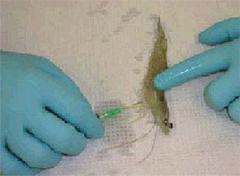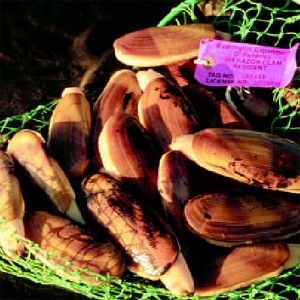| NOAA Magazine || NOAA Home Page |
 September
2, 2004 — The oceans and Great Lakes are inextricably linked to
human health in both coastal and inland areas. Despite this critical bond,
very little is known about the relationships between the oceans and human
health. The new NOAA
Oceans and Human Health Initiative is designed to address this issue
by bringing together expertise within NOAA and building external partnerships
with ocean and human health experts from both the public and private sectors,
including academia.
Although the OHHI will look at all aspects of this issue — from
human impacts on the health of the oceans and Great Lakes to how, in turn,
these bodies of water affect human health — the primary focus will
be on the latter and on the development of information useful for decision
makers.
September
2, 2004 — The oceans and Great Lakes are inextricably linked to
human health in both coastal and inland areas. Despite this critical bond,
very little is known about the relationships between the oceans and human
health. The new NOAA
Oceans and Human Health Initiative is designed to address this issue
by bringing together expertise within NOAA and building external partnerships
with ocean and human health experts from both the public and private sectors,
including academia.
Although the OHHI will look at all aspects of this issue — from
human impacts on the health of the oceans and Great Lakes to how, in turn,
these bodies of water affect human health — the primary focus will
be on the latter and on the development of information useful for decision
makers.
The initiative is comprised of a suite of complementary internal and external competitive programs. As part of the OHHI, NOAA established a trio of research centers in Seattle, Wash.; Charleston, S.C.; and Ann Arbor, Mich.
Building on NOAA’s broad strengths, the goal of the NOAA OHHI is to support an ecosystem approach to better understand and predict ocean-related human health impacts. This research, and related activities, will help NOAA and its partners better address many of the challenges decision-makers face in the areas of public health and natural resource management. The initiative will also evaluate the health benefits and risks of seafood and promote the discovery of pharmaceuticals and bioactive agents from the sea to benefit human health.
 A
broad array of interrelated research topics will be addressed through
this initiative, including marine
toxins and pathogens, chemical
pollutants, water quality, beach
safety, seafood quality,
sentinel species (and other indicators of environmental health) and the
discovery of pharmaceuticals
and bioagents.
Not only will the program enhance NOAA’s knowledge in these areas,
but it will also strengthen existing (as well as foster new) partnerships
both within NOAA and related academic, public and private sector entities.
A
broad array of interrelated research topics will be addressed through
this initiative, including marine
toxins and pathogens, chemical
pollutants, water quality, beach
safety, seafood quality,
sentinel species (and other indicators of environmental health) and the
discovery of pharmaceuticals
and bioagents.
Not only will the program enhance NOAA’s knowledge in these areas,
but it will also strengthen existing (as well as foster new) partnerships
both within NOAA and related academic, public and private sector entities.
“By increasing our understanding of the linkages between oceans and human health, the NOAA OHHI supports two of NOAA’s primary mission goals — to protect, restore and manage the use of coastal and ocean resources through ecosystem-based management and to understand climate variability and change to enhance society’s ability to plan and respond,” said retired Navy Vice Adm. Conrad C. Lautenbacher, Ph.D., undersecretary of commerce for oceans and atmosphere and NOAA administrator.
Critical
Links Between the Oceans and Human Health
In
recent years, the world has gained a renewed appreciation for the importance
of the oceans to human health and well being. Ironically, the oceans affect
human health in both positive and negative ways. In order to both guard
against human health threats and to take advantage of the many services
the oceans provide (i.e., sustenance, recreation and potential medicinal
benefits) the link between oceans and human health must be more fully
understood.
Benefits
of Oceans on Human Health
The oceans benefit human health by providing a valuable global
food source, providing protein and other important nutrients (i.e., omega
three fatty acids) from fish and shellfish. In fact, the United States
is the third largest consumer of seafood in the world. The oceans also
provide a source of employment, relaxation and inspiration. Millions of
people live near the coasts and millions more visit and participate in
marine-related recreation each year. In addition, the oceans can benefit
human health by providing a wide variety of marine compounds believed
to be useful in biomedical applications (i.e., new pharmaceuticals) and
can provide important clues — through sentinel species (i.e., first
response organisms to environmental stressors) — as to current and
potential human health risks, which will enable us to better prevent and
reduce serious threats to human health.
 Human
Health Risks Posed by the Ocean
Human
Health Risks Posed by the Ocean
In contrast to these life-supporting benefits, the Earth's oceans
(and Great Lakes) also harbor disease-causing organisms and other harmful
agents (such as toxic chemicals and marine biotoxins) that can impact
human (and marine) life. Most human illnesses associated with oceans and
coastal areas derive from the:
- Consumption of seafood contaminated with pathogens, biotoxins or toxic chemicals;
- Exposure to a variety of harmful pathogens through direct contact with ocean waters and
- Exposure to toxins from harmful algae.
Human activities (such as sewage/wastewater disposal, nutrient runoff from agriculture and other land uses, coastal development and associated habitat destruction and even the transfer of organisms via ballast water) can trigger or exacerbate human health risks associated with the oceans.
In addition to the direct effects of human activities, natural environmental processes can also contribute to these risks. For example, various marine processes can affect the distribution and proliferation of disease-causing organisms through estuarine, coastal and ocean basin circulation; tidal fluctuations and seasonal temperature shifts. Likewise, climate and weather systems can also cause marine biotoxins, toxic chemicals and pathogens to accumulate in certain areas or spread through short-term dramatic events (such as storm surges, heavy rains and winds), as well as long-term fluctuations related to oceanic trends (e.g., El Niño, Pacific Decadal Oscillation).
 Need
for Greater Understanding of Oceans and Human Health
Need
for Greater Understanding of Oceans and Human Health
The oceans are a life-sustaining resource that demands proper
stewardship to take full advantage of the benefits and guard against the
human health threats they pose. The NOAA OHHI is prepared to take on this
challenge. As the U.S. Commission
on Ocean Policy (2004) stated in its preliminary report, “significant
investment must be put into developing a coordinated national research
effort to better understand the links between the oceans and human health.”
Established by Congress in 2003, the NOAA OHHI has allowed NOAA to build
on its expertise by coordinating all its ocean and human health related
activities and implementing critical interdisciplinary research. The initiative
includes internal and external peer-reviewed research, a distinguished
scholars and traineeship program and three competitively awarded NOAA
Oceans and Human Health Research centers (in Seattle, Wash.; Charleston,
S.C., and Ann Arbor, Mich.). Each of the NOAA centers will receive just
over $2 million for the first year, with much of that going to external
partners. Total combined funding for the initiative in FY03 and FY04 is
$18 million. The Oceans and Human Health Act, S.1218, introduced in June
2003 and now passed by the Senate, provides a blueprint for the OHHI.
The NOAA OHHI and its trio of centers will work closely with the four recently established National Science Foundation/National Institute of Environmental Health Sciences Centers of Excellence in Oceans and Human Health, to ensure a comprehensive and compatible federal approach to oceans and human health research.
 NOAA
Ocean and Human Health Centers
NOAA
Ocean and Human Health Centers
Designed as the cornerstone of the initiative, the three NOAA
OHHI centers are built on partnerships with the federal, state, academic
and nonprofit communities and will address a suite of scientific issues.
To address these issues, each center will use state-of-the-art laboratory,
field and computer modeling techniques. Each center will also develop
a strong outreach and education program to share data and research results
with the public and other science institutions, foster the exchange of
information between diverse communities and provide valuable education
resources and opportunities. The NOAA OHHI centers are located at the:
- NOAA Northwest Fisheries Science Center in Seattle, Wash.: This center uses a broad-based ecosystem approach and state-of-the-art biotechnology, models and environmental assessments to investigate the sources, transport and fate (e.g., distribution and persistence) of harmful pathogens, biotoxins and toxic chemicals in seafood (fish and shellfish) under changing ocean conditions (e.g., El Niño) and human/land use activities. By examining these aspects, NOAA will be able to develop early warning systems to better predict where outbreaks may occur (for example) and methods to reduce or eliminate these harmful agents from seafood (such as through molecular or specific seafood preparation techniques). The center will also use marine mammals and fish as sentinel species to understand and evaluate potential risks to humans who are exposed to a similar suite of pathogens, biotoxins and toxic chemicals. The research at this center will provide the information needed to make sound decisions about the risks and benefits of seafood consumption and to support natural resource and human health managers in forecasting and reducing threats to human health. Key partners include the University of Washington, the Marine Mammal Center, Oregon State University, Institute for Systems Biology, Washington State University, University of California, Davis and the NOAA Alaska Fisheries Science Center. Usha Varanasi, Ph.D., director of the NWFSC, is the center’s director.
- NOAA Hollings Marine Laboratory in Charleston, S.C.: This center addresses fundamental questions about the quality and safety of coastal waters and the seafood they produce. To accomplish its objectives, center scientists will develop new methods, approaches and tools to: evaluate the health responses of marine organisms to multiple stressors, and identify and characterize chemical and microbial threats to marine ecosystems and human health. The center will also establish three core research areas: applied marine genomics, chemical contaminants and source tracking of marine pathogens. HML will conduct a field program in shallow tidal creeks and estuaries to determine the reliability of the new methods and tools for application by national and regional monitoring and assessment programs. The HML will complement its research activities with education and outreach activities that train the next generation of scientists and teachers. HML is operated in partnership with NOAA, the National Institute of Standards and Technology, South Carolina Department of Natural Resources, College of Charleston and the Medical University of South Carolina. Each partner brings unique expertise to the HML and all of the partners have critical roles in the center. Fred Holland, Ph.D., director of HML, is be the center’s director.
- Great Lakes Environmental Research Laboratory in Ann Arbor, Mich.: This center uses multidisciplinary research to develop technology for predicting the formation, location and severity of toxic algal blooms, beach closings and water quality in the Great Lakes basin. The goal of the center is to use GLERL’s broad scientific expertise to significantly reduce threats to human health through ecological forecasting. This effort will utilize the lab's high tech modeling capabilities, as well as advanced scientific understanding of climate, weather, hydrologic, land use and biological processes. In addition to modeling, the center's research includes laboratory work and field experimentation. The center will also develop a strong outreach and education program for public and user communities to raise awareness of Great Lakes human health issues. Key partners include Michigan State University, University of Michigan, Florida Institute of Oceanography, U.S. Environmental Protection Agency, the U.S. Geologic Survey and the NOAA Beaufort Laboratory. Stephen Brandt, Ph.D., director of GLERL, will be the center’s director.
"The unique combination of these three centers allows NOAA to focus an unparalleled combination of basic, applied and biomedical research expertise — including risk assessment and forecasting — on questions of paramount importance to maintaining the health of our coasts and the humans that live there," said Juli Trtanj, NOAA OHHI program director.
 Human
interaction with the oceans is central to NOAA’s ecosystem-based
approach to management of the nation’s living marine resources and
the habitats on which they depend. The NOAA OHHI will bring NOAA’s
understanding and assessment full circle since it will both evaluate human
impact on the oceans, as well as the the impact of the oceans on human
health.
Human
interaction with the oceans is central to NOAA’s ecosystem-based
approach to management of the nation’s living marine resources and
the habitats on which they depend. The NOAA OHHI will bring NOAA’s
understanding and assessment full circle since it will both evaluate human
impact on the oceans, as well as the the impact of the oceans on human
health.
Understanding
the relationship between the oceans and human health is a challenging
interdisciplinary field of study, but it is increasingly clear that it
is in the nation’s best interest to provide federal support and
coordination of this research effort. As a result, NOAA will continue
to advance its research and collaborative partnerships in this area to
shed light on some of the complex relationships between oceans and human
health and to provide useful information to policy and decision makers
addressing this issue.
Relevant
Web Sites
NOAA Ocean
and Human Health Initiative
Request
for Proposals for
NOAA Centers of Excellence in Oceans and Human Health
External Grant Funding Opportunity – NOAA Oceans and Human Health
HAPPY
BIRTHDAY NWFSC: CELEBRATING 70 YEARS OF FISHING SCIENCE A Celebration
of Scientific Inquiry
Harmful
Algal Blooms
PERSPECTIVES ON THE COASTAL NONPOINT PROGRAM
NOAA’S
NORTHWEST FISHERIES SCIENCE CENTER: WHERE THE MYSTERIES OF FISH AND THEIR
UNDERWATER WORLD ARE DISCOVERED
NOAA’s GREAT LAKES ENVIRONMENTAL RESEARCH LABORATORY
NOAA
Hollings Marine Laboratory
Media
Contact:
Jana
Goldman, NOAA Research, (301)
713-2483